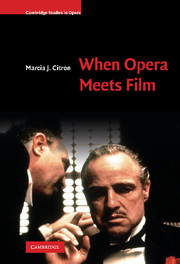Book contents
- Frontmatter
- Contents
- List of figures
- List of tables
- List of music examples
- Acknowledgments
- Introduction
- Part I Style
- 1 Operatic style in Coppola's Godfather trilogy
- 2 Opera as fragment: “Liebestod” and “Nessun dorma” in Aria
- Part II Subjectivity
- Part III Desire
- Epilogue
- Notes
- Bibliography
- Filmography and videography
- Index
2 - Opera as fragment: “Liebestod” and “Nessun dorma” in Aria
from Part I - Style
Published online by Cambridge University Press: 04 August 2010
- Frontmatter
- Contents
- List of figures
- List of tables
- List of music examples
- Acknowledgments
- Introduction
- Part I Style
- 1 Operatic style in Coppola's Godfather trilogy
- 2 Opera as fragment: “Liebestod” and “Nessun dorma” in Aria
- Part II Subjectivity
- Part III Desire
- Epilogue
- Notes
- Bibliography
- Filmography and videography
- Index
Summary
At the end of Aria one must decide, I suppose, what it all means … You could almost call Aria the first MTV version of opera.
Roger EbertIn 1987 British producer Don Boyd released an unusual operatic film. Entitled Aria, it consists of ten segments drawn from different operas, each filmed by a different director. Each could choose their own repertoire and film it any way they wished. Boyd encouraged contributors to devise fanciful visualizations for the music and avoid traditional renditions of the story. Each segment had to be less than ten minutes in length and use music from the recorded catalogue of RCA, a major sponsor of the project. Celebrity directors such as Federico Fellini and Woody Allen were originally going to participate, but had to drop out because of scheduling conflicts. The final result includes a few famous names – notably, Jean-Luc Godard, Robert Altman, and Ken Russell – but most of the contributors are British directors who were young and relatively unknown at the time (see Table 2.1).
Not surprisingly for an anthology, the filming styles that resulted are quite varied – from dreamlike exotic fantasy (Russell) to gloomy black-and-white documentary (Charles Sturridge), from swooping cam-like montage (Altman) to a relatively fixed camera (Bruce Beresford), from hyper-real color schemes (Franc Roddam) to a matter-of-fact palette (Godard). The repertoire also spans a wide range.
- Type
- Chapter
- Information
- When Opera Meets Film , pp. 58 - 94Publisher: Cambridge University PressPrint publication year: 2010



